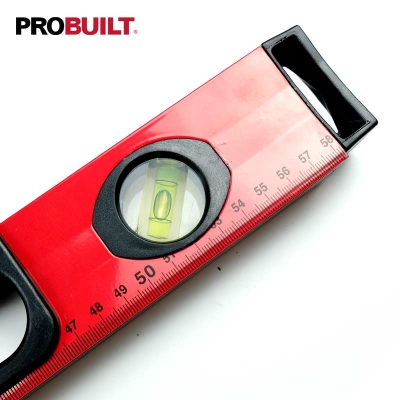+86 311 8533 5186
Every contractor and builder has a few essential tools in their arsenal, one of which is a level.
A good level will ensure that everything you build is true and accurate. With a level you can be sure to make a square out of what you create.
There are many types of levelers on the market. Some are versatile and can be used in a variety of situations. But some machines have more specific uses. Probuilt wholesale measuring tools takes you through the commonly used levels and when to use them to make sure all your projects run smoothly.
The most common and versatile type is the box beam level, also known as a box level. Box beam levels consist of a square or box-shaped frame. They are usually extruded metal. Usually aluminum.
They usually have an easy to handle grip and usually have one or more vials for reading. In North America, box beam levels usually have a milled edge of the gauge that touches the surface being measured.
You can also use a vertical box beam level to measure plumb. This makes it a versatile tool for measuring both vertical and horizontal planes.
Any level of this shape is considered a box beam level, regardless of the material of its composition. Wooden levels and other materials such as carbon fiber are only a small part of the levels sold in North America.
Adding a magnet to a level is a great feature if your material requires it. Masons or wood framing carpenters rarely use magnets. Commercial carpenters, on the other hand, may carry many magnetic levels.
A magnetic box beam level will adhere firmly to a magnetic surface. This tool can be helpful if you want to take a quick hands-free reading on a magnetic surface. When you want to check if an object is straight or flat. For more accurate measurements, there are usually digital forms available as well.
Find the horizontal or vertical vial on the level and observe the two lines
Your level may have two vials or tubes of liquid: one horizontal and one vertical. You will use the horizontal vial to find the horizontal surface. You will notice bubbles in the vial with two lines in between. These two lines are called guidelines.
When you measure a horizontal object, if the bubble lies between the two guidelines and the bubble is perfectly flat, it is an indication that the object is horizontal. Another way to think about it is that the horizontal object is perfectly parallel to the horizon.
If, when measuring a horizontal object, you find that the bubble is outside the left-hand criterion. This indicates that the left side of your object is higher than the right side. If the bubble is outside the right-hand side guideline, this indicates that your right side is higher than your left side.
When you measure a vertical object, if the bubble lies between the two thresholds, this indicates that it is perfectly vertical. A plumb object is perpendicular to the earth.
If in your vertical measurement you find that the bubble lies outside the top guideline. The top of the object will bulge forward. If the bubble is outside the bottom guideline, then the bottom of the object will bulge forward.
Clean the level and object before reading
Dirt and debris can affect the level and the level is very sensitive. Simply brushing the level and object with a gloved hand is sufficient to ensure an accurate reading. If you use your level frequently, remove any dirt that accumulates on the edges.
Place your level in the center of the object
Your level object may be a few bricks. A framed picture, a deck, or even the floor. Meanwhile vertical objects can be walls, cabinets, door frames or fence posts. Make sure that the bubble is within the guidelines.
Double check by moving the level off center
Move the level to the right or left for horizontal readings and to the top or bottom for vertical readings. Sometimes the level has damage or defects that cause inaccurate readings. You can make sure the readings are the same by repositioning the level on the object.

Copyright © Sinotools Industrial All Rights Reserved.. Technical Support: